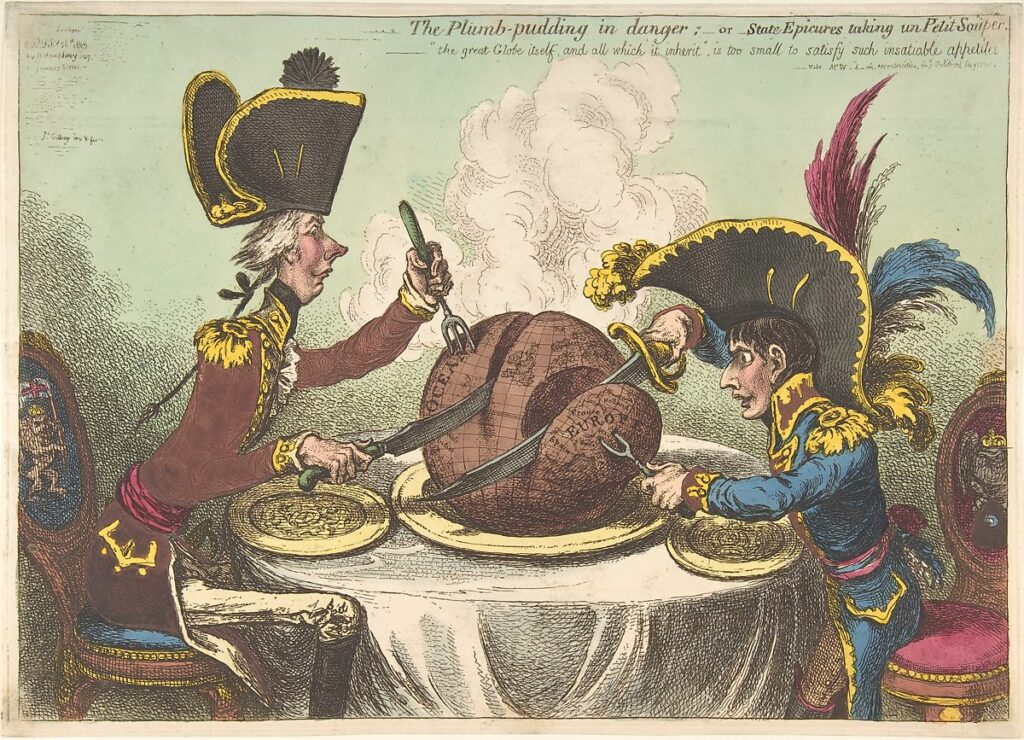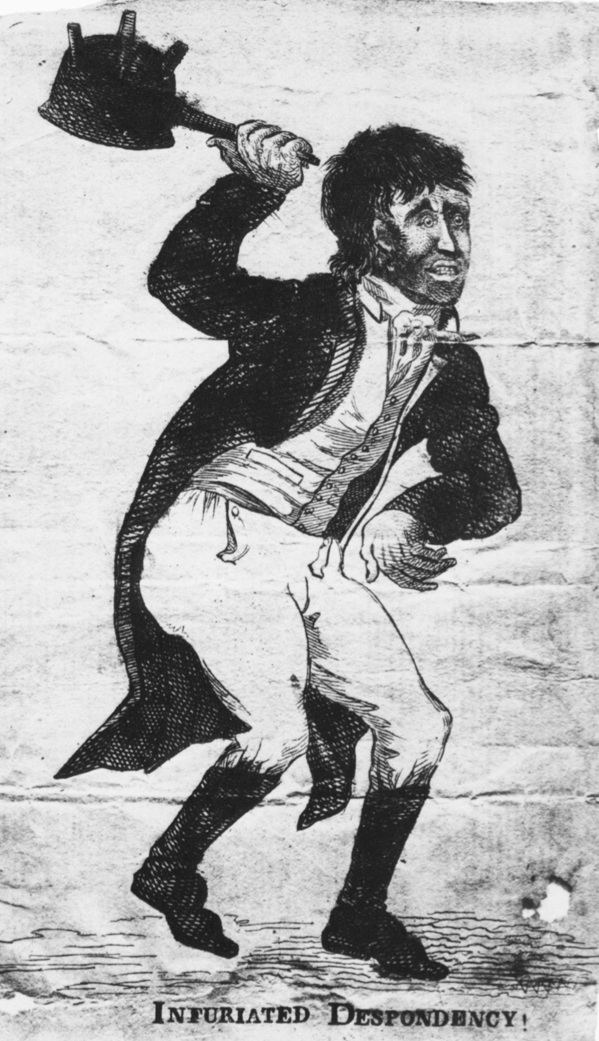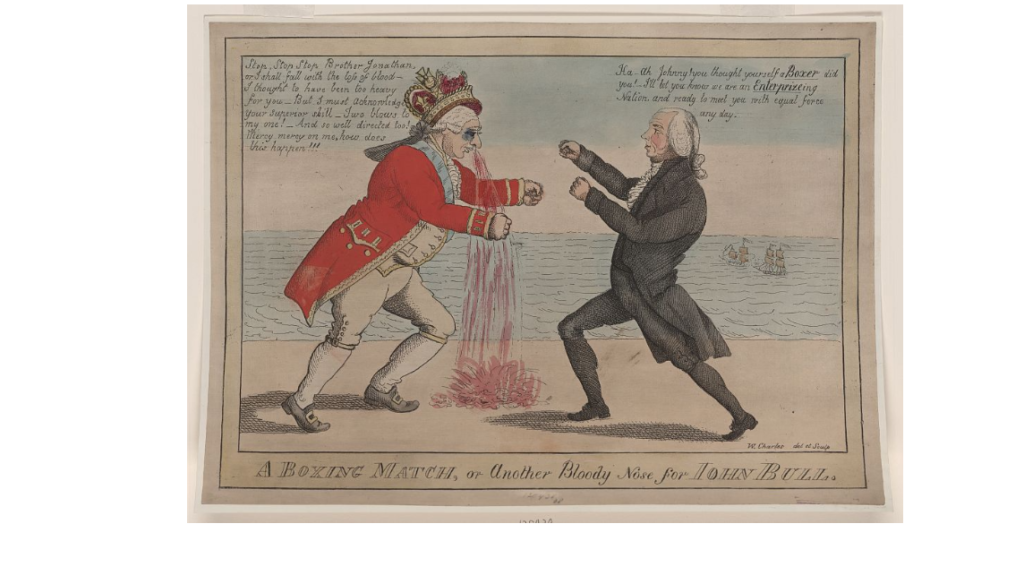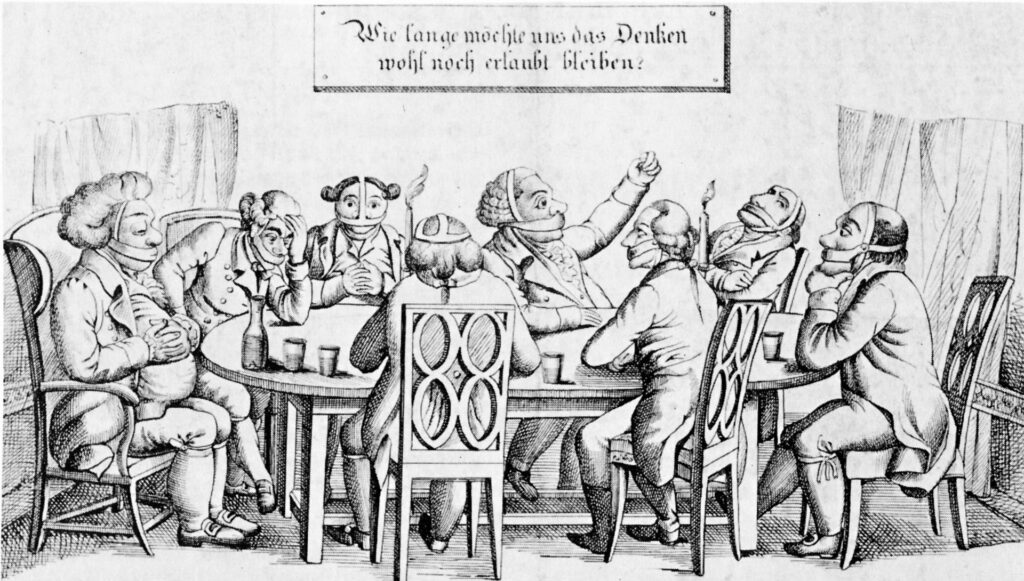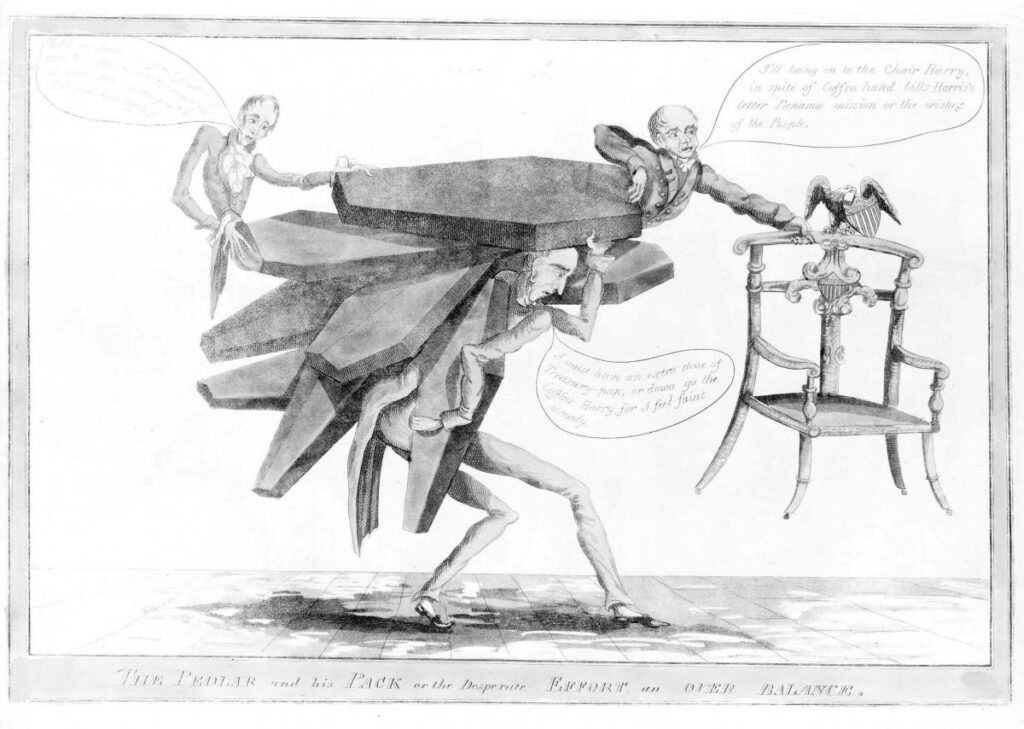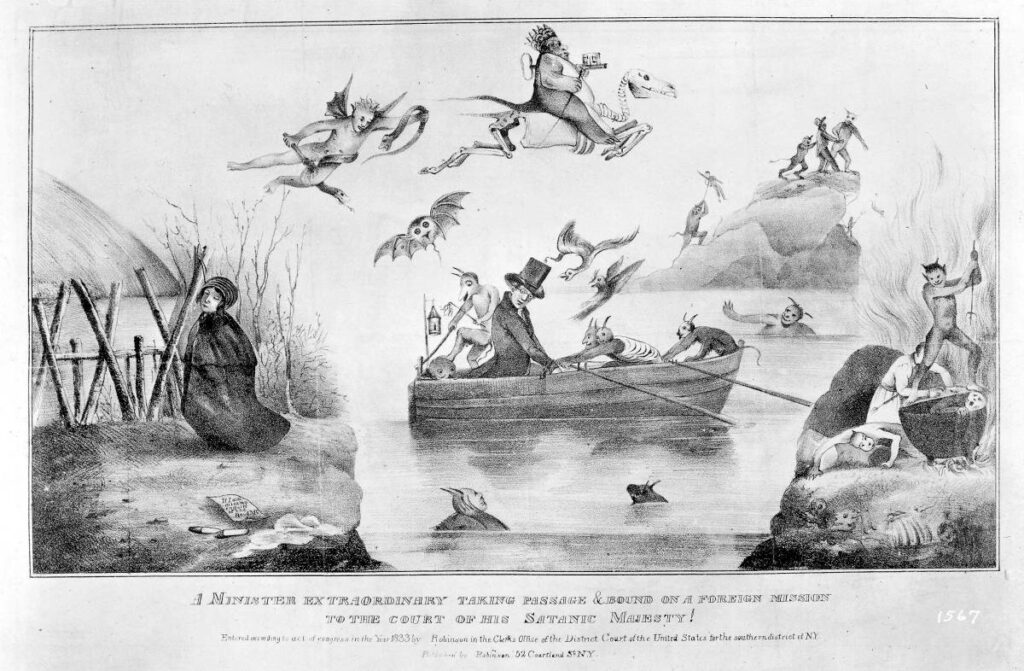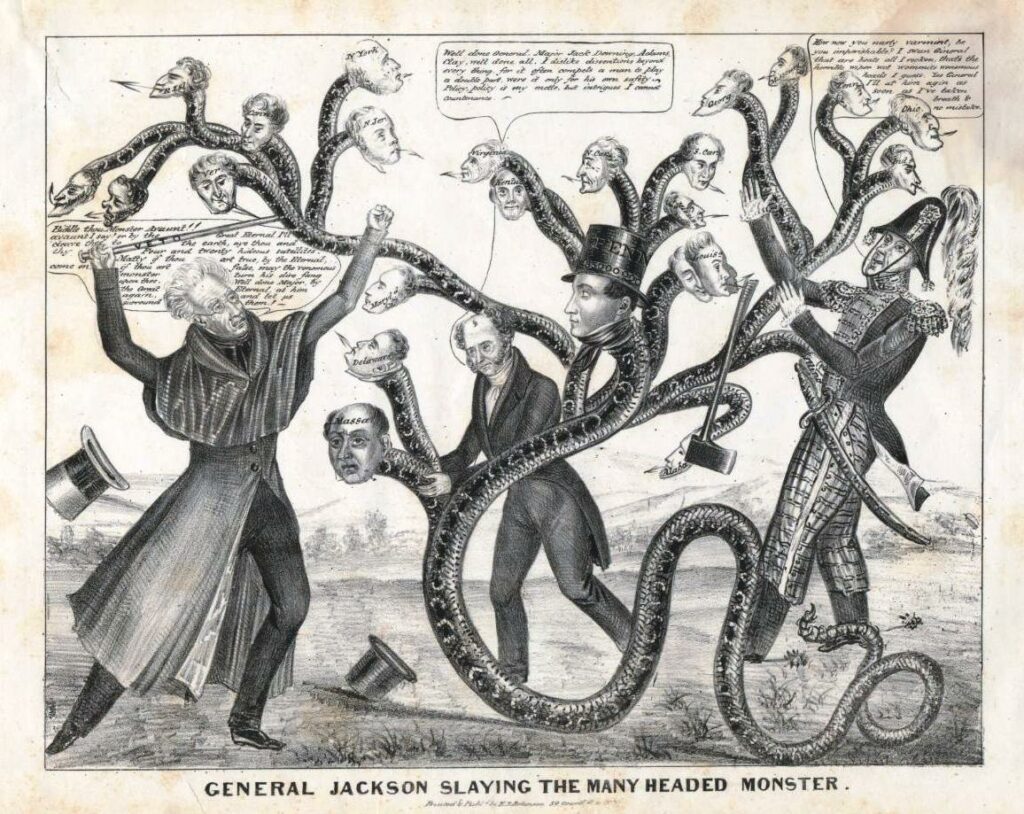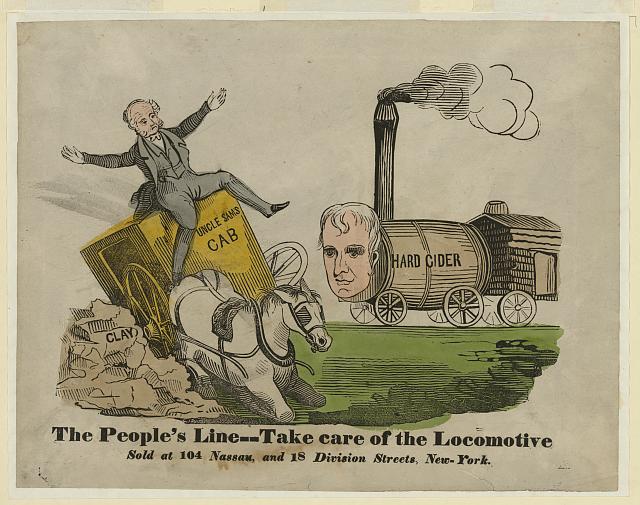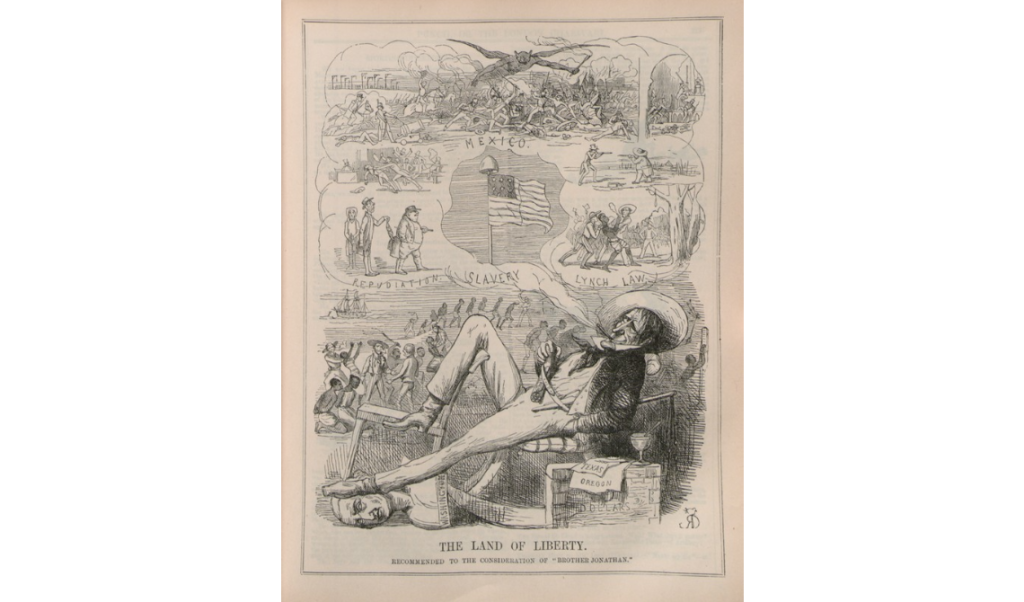Political cartoons developed significantly during the early nineteenth century.
British caricaturist James Gillray, known as “the father of the political cartoon,” famously satirized King George III, Napoleon Bonaparte, prime ministers, and the generals of the Napoleonic era. His work increased the popularity and artistic development of the medium on both sides of the Atlantic and was characteristic of the increasingly free press in a liberalizing Western world. Gillray’s most famous cartoon, The Plumb-Pudding in Danger, was described by modern British political cartoonist Martin Rowson as “probably the most famous political cartoon of all time.”
By the mid-nineteenth century, political cartoons were common throughout the western world, and the most influential cartoons were created for the British periodical Punch. Founded in 1841, Punch capitalized on new mass printing technologies to become the preeminent British magazine of the mid-nineteenth century. Punch relied on political cartoons and illustrations to boost the magazine’s appeal, and was the first magazine to use the term “cartoon” to refer to comic drawings.
The quality and quantity of Punch’s cartoons demonstrated the popularity of the medium to publishers in Europe and North America and spawned a variety of American imitators including Judge, Puck, and others.
Click on each image to enlarge.
The Plumb-Pudding in Danger
James Gillray, 1805, London, England
This cartoon depicts the world being carved up into spheres of influence between British Prime Minister William Pitt (left) and Napoleon (right).
Infuriated Despondency!
James Akin, 1805, Newburyport, Massachusetts
James Akin was one of America’s first renowned political cartoonists. In the early 1800s, Akin was working as an engraver for Edmund March Blunt, a publisher and newspaperman, in Newburyport, Massachusetts. In 1804, Akin and Blunt had a heated public argument which culminated in Blunt hurling a cast iron skillet at Akin’s head. The skillet missed Akin and hit an unfortunate passerby instead. Akin retaliated with a mocking print of Blunt entitled Infuriated Despondency. The caricature was later featured in the Newburyport Herald and the incident amused people throughout the world. The image of the skillet-wielding Blunt depicted in Infuriated Despondency was a popular design motif for a time and was used to decorate chamber pots as far away as London.
A Boxing Match, or Another Bloody Nose for John Bull
Charles Williams, 1813, Philadelphia, Pennsylvania
This cartoon, depicting the War of 1812, shows American president James Madison punching King George III in the face. Madison is referred to as “Brother Jonathan,” the male personification of the United States in the early nineteenth century. “John Bull” is the male personification of Britain. Characters representing larger political and geographic entities became common during the nineteenth century.
The Thinkers Club (German: Der Denker-Club)
Anonymous, 1819, German Confederation
In 1819, leaders in Germany enacted the Carlsbad Decrees which banned nationalist groups, removed liberal university professors, and expanded the censorship of the press. In this cartoon, eight muzzled caricatures sit around a table, unable to speak freely. The plaque above the table reads: “The most important question of today’s meeting: how long will Thinking be allowed to us?”
The Pedlar and his Pack or The Desperate Effort an Over Balance
James Akin, 1828
The Coffin Handbills were a series of pamphlets attacking Andrew Jackson during the 1828 United States presidential election, in which he ran against incumbent John Quincy Adams. The handbills depicted coffins representing people who had died needlessly under Jackson’s command throughout his military career. The pamphlets backfired when Jackson responded by launching a tirade of matching vitriolic personal attacks against Adams which damaged the latter’s reputation. This cartoon depicts John Binns, the newspaper editor responsible for the Coffin Handbills, vainly trying to hoist up and balance John Q. Adams and his Secretary of State Henry Clay with little success.
A Minister Extraordinary Taking Passage & Bound on a Foreign Mission to the Court of His Satanic Majesty!
Henry Robinson, 1833, New York, New York
Ephraim Avery was a Methodist minister acquitted, despite overwhelming evidence to the contrary, of murdering a young factory worker named Sarah Maria Cornell in 1832. Loaded with religious, economic, and social controversy, the trial captivated the nation. This cartoon depicts Avery being ferried off to Hell with the body of the lifeless Cornell behind him.
General Jackson Slaying the Many-Headed Monster
Henry R. Robinson, 1836, New York, New York
President Andrew Jackson, vice president Martin Van Buren, and Major Jack Downing battle the “many-headed monster” that is the Bank of the United States which Jackson despised. The heads on the snake represent the many state banks that supported the Bank of the United States. Major Jack Downing was a fictional character created by cartoonist Seba Smith for the Portland Courier. Always getting into trouble, Downing was a gullible Maine farmer who went to Washington D.C. to make a name for himself and ended up in misadventures such as the one depicted. Henry R. Robinson co-opted Downing for this cartoon. Later in his life, although the details are vague, Robinson was arrested for selling “obscene pictures and books.”
The People’s Line — Take Care of the Locomotive
Huestis & Company and Robert Elton, 1840, New York, New York
This cartoon supports William Henry Harrison’s candidacy for the 1840 United States presidential election. Incumbent president Martin Van Buren drives “Uncle Sam’s Cab,” a carriage pulled by a blind horse, into a pile of “Clay,” representing Henry Clay. The carriage flounders in the path of a train with presidential candidate William Henry Harrison’s head on it. Van Buren and Clay were Harrison’s rivals in the election. Harrison’s train is made up of hard cider and a log cabin, both of which were symbols of the “common man” at the time.
The Land of Liberty
Richard Doyle, 1847, for Punch Magazine, London, England
The Land of Liberty presents a contented Brother Jonathan, one of the personifications of the United States during the nineteenth century, smugly smoking while holding a whip and a gun as he rests his feet on a bust of George Washington. In his smoke are scenes of slavery, corruption, gun violence, brawling, and imperialism. Around Brother Jonathan are enslaved people being abused, a box with “dollars” written on it, and two papers marked “Texas” and ”Oregon” which refer to the United States’ recent acquisition of those two territories. This cartoon ironically points out the hypocrisy of “the land of liberty” from a British perspective.


